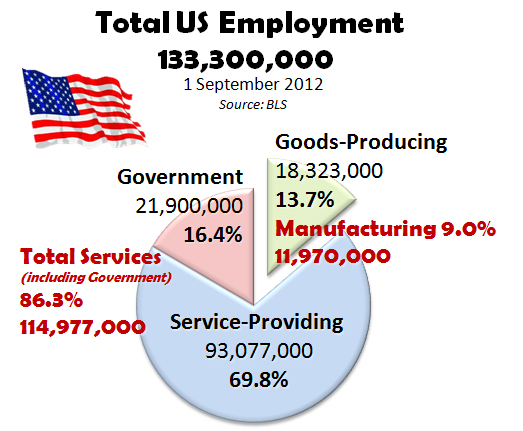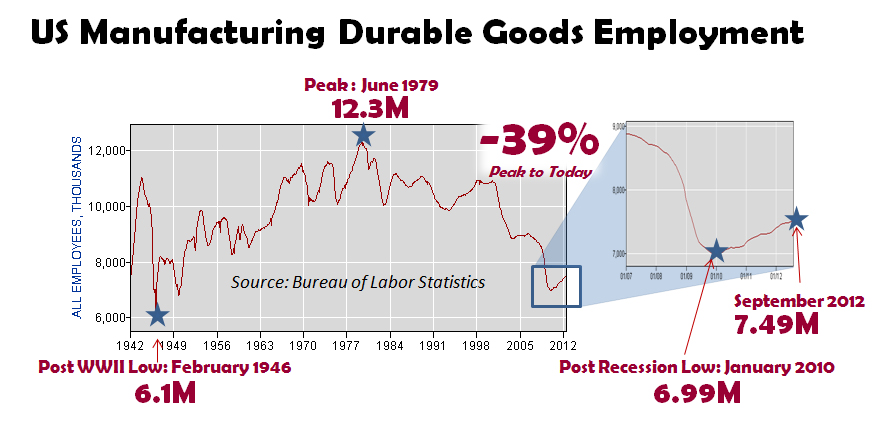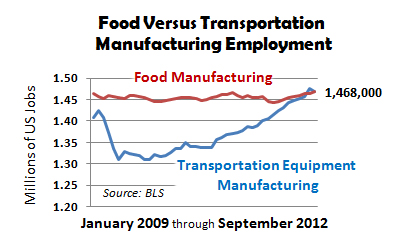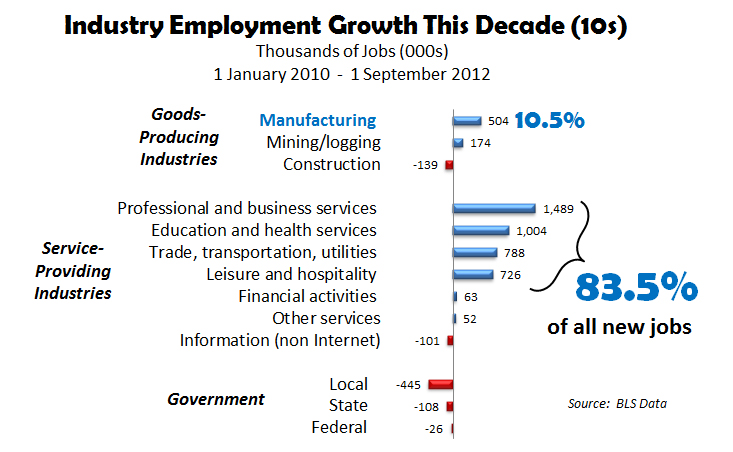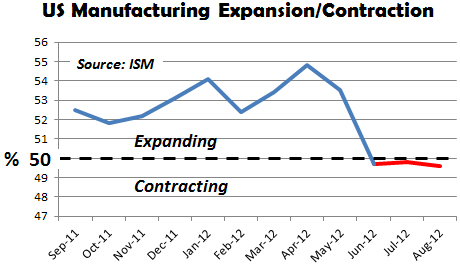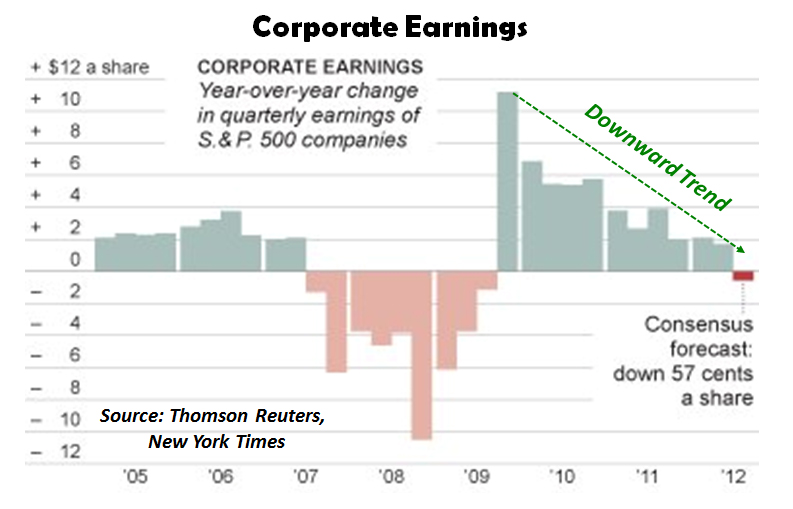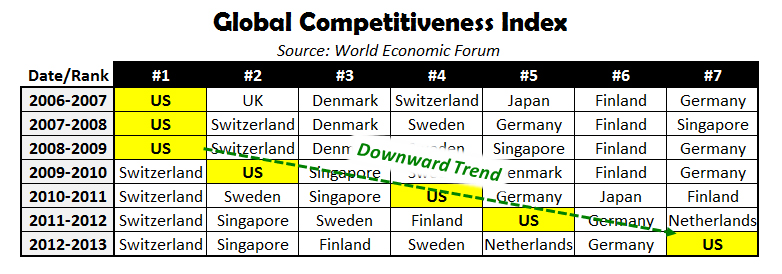Executive Summary: US manufacturing is not likely to employ significantly more Americans than it currently employs.
Overview: Manufacturing is a vital component of our economy. Unfortunately, Americans have unrealistic expectations regarding the role of the manufacture sector in our economic recovery as well as jobs creation. The American economy is dominated by service-providing industries that employ the 86% of all Americans. Manufacturing (part of the goods-producing sector) employs only 9%. Correspondingly, American policy-makers and opinion-leaders do disservice to the American public by heralding manufacturing over other industries. Reasonable rates of employment and economic recovery can only be achieved via a balanced approach to resourcing and supporting all growth industries. Most Americans understand how we transitioned from an agriculturally-based society to an industrial-based society, but have not come to terms with the ramifications of a postindustrial, services-based, internet-empowered society that is significantly less dependent on domestic manufacturing.
Total US Employment. Out of a total population of 314 million, America employs 133 million people in three sectors: service-providing industries, goods-producing industries, and government services. 115 million Americans (including government employees) are employed in service related jobs, which equates to 86.3% of all working Americans. The service-providing sector employs 93 million Americans. Government (federal, state, local) is the second largest employer at 21.9 million. The goods-producing sector is the smallest with 18.3 million. Manufacturing is the largest goods-producing industry that employs 11.97 million, which equates to 9% of all working Americans or 3.8% of our population. At 9%, it is difficult to assert that the US is an industrial or manufacturing-based society. With 86% in service related jobs, America is better defined now as a postindustrial, services-based country.
Recent US Manufacturing Employment Statistics. US manufacturing employment decreased 39% from its pre-recession high. If adjusted for population growth, the declination is 55%. Over the last two years, manufacturing employment has increased 4% but is now trending downward. Jobenomics predicts that the entire US manufacturing sector (durable and nondurable goods) will not produce significantly more jobs than it currently does. 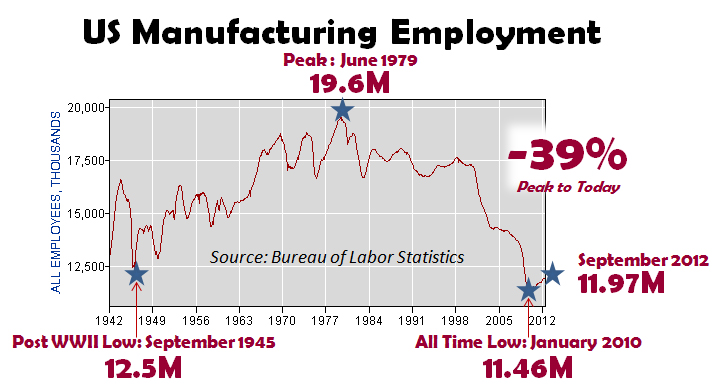
In 1946, 11.9 million Americans were employed in manufacturing. By 1979, manufacturing grew to 19.5 million. Then the decline began. Over the last three and a half decades, manufacturing has declined 39% to 11.97 million today. Since the post-Great Recession low in January 2010, manufacturing has grown by approximately 500,000 people. This is good news, but insufficient evidence to believe that a manufacturing renaissance is underway.
The US manufacturing sector is comprised of durable and nondurable goods. Durable goods consist of machinery, appliances or equipment that are not easily consumed or destroyed during use and lasts for over three years. Nondurable goods are items, such as food and apparel that are used up quickly or purchased infrequently.
Durable goods have suffered a 39% decline from the peak in 1979 and now employ 7.5 million people or 63% of the total manufacturing sector. From its post-recession low in January 2010, durable goods have added approximately 500,000 jobs or a gain of 7%. Much of this gain can be attributed to generous federal government stimuli and bailouts (e.g., the auto industry).
There are 10 durable goods industries or subsectors as defined the US Department of Labor’s Bureau of Labor Statistics (BLS) as shown above. The transportation/motor vehicles/equipment sector is the largest subsector with 1,468,000 employees.
The American public generally associates the automotive industry with this durable goods industry. However, according to the BLS[1], the entire US automotive industry (both foreign and domestic manufactures) only employs only 772,000 people in motor vehicles and parts manufacturing, or 10% of the durable goods sector, or 6% of the manufacturing sector, or 1% of all working Americans, or 0.2% of all American citizens. These percentages are offered not to diminish the importance of auto industry manufacturing, but rather to emphasize that there are a host of other industries and sectors that are equally critical to the American economy.
One could argue that the auto industry supports a vibrant retail trade (services-providing industry) with 1,716,500[2] Americans employed by motor vehicle and parts dealerships as well as another 815,000 independent automotive repair and maintenance personnel. This is true. Automotive manufacturing supports a large indirect jobs tail. However, it is also true that US automotive manufactures are no longer the dominant vehicle provider in America. In September 2012, out of a total of 1,188,865 light vehicle sales[3] made in America, only 44% (538,752 vehicles) were manufactured by American auto manufactures (GM, Ford and Chrysler). Consequently, foreign automotive manufacturers now have a longer indirect jobs tail in the US than American auto manufacturers. This large indirect tail of dealer and maintenance jobs would exist even if the Big 3 did not. This is not meant to imply that the Big 3 and domestic manufacturing is not important. It is vitally important. The point is that automotive manufacturing, as well as other durable and nondurable goods manufacturers, may not be the job creators that most Americans expect. Our limited resources should be invested in industries that have the most economic and jobs creation potential.
Nondurable goods have suffered a 38% decline from the peak in 1979 and now employ 4.5 million people or 37% of the total manufacturing sector. From its post-recession low in October 2010, nondurable goods have added an insignificant number of new jobs.
Coincidently, the largest nondurable goods industry, food manufacturing, employs exactly the same number of people (1,468,000) as the largest durable goods industry, transportation, and twice as much as the entire automotive manufacturing industry. In addition, as shown above, food manufacturing was much more stable after the Great Recession and did not need stimuli, bailouts and buyouts from the US government and its taxpayers.
Industry Employment Growth. As stated previously, manufacturing employs 9% of all working American’s, but how has it grown compared to other US industries?
Since the beginning of this decade (1 January 2010) with a growth rate of 10.5% over this 32 month period, the manufacturing sector is the fifth best jobs generator out of thirteen US sectors. This is a welcome development after decades of steady decline. Will this growth continue in the future? Probably not.
The latest Manufacturing ISM Report on Business[4] data (depicted above) shows that US manufacturing contracted in two of the last three months. This is the first contraction since June 2009 at the end of the Great Recession. Since the Great Recession, US manufacturing trended upward, leveled and is now trending downward. Note: the Manufacturing ISM Report index uses values over 50% as positive (expanding) and values under 50% as negative (contracting).
This downward trend follows general corporate trends like declining corporate earnings that are predicted to go negative in the first quarter of 2013[5] after positive growth in the eleven previously positive quarters (see posting entitled, Uncle Sugar High). To a large extent corporate earnings and manufacturing recapitalization are inextricably linked. Corporations are less likely to invest and hire with poor earnings.
In addition, the World Economic Forum (WEF)’s annual forecast[6] shows a rapid downward trend in American global competitiveness after being #1 for years. The WEF is an independent international organization committed to improving the state of the world by engaging business, political, academic and other leaders. Out of 144 countries, the WEF ranks the US #1 in market size, #6 innovation, #10 business sophistication, #8 higher education and training, #23 goods market efficiency, #34 primary education, and #111 macroeconomic environment (i.e., low public trust in politicians and a perceived lack of government efficiency). In 2006, the United Kingdom was #2, but disappeared thereafter. Hopefully, the US will reverse the downward trend. Competitiveness is paramount to success.
In the long-term, Jobenomics predicts that the manufacturing industry will not produce a significant number of new jobs for the following reasons:
- While the recent uptick in manufacturing jobs over the last few years has been slightly positive, the headwinds of the last three decades have not significantly abated.
- Emerging economies with lower labor rates, less regulations, better technical skills, and greater government underwriting will continue to be competitive in global manufacturing.
- US corporations will continue to outsource jobs to emerging economies despite government pressure and incentives to re-shore jobs. Many of the domestic job openings that require hi-tech skills will remain unfilled.
- The political ideological divide will prevent any meaningful pro-business policies, or significantly reduce the regulatory environment.
- The advent of the third industrial revolution has shifted the manufacturing equation from labor-intensive to technology-intensive and from jobs-heavy to jobs-lite with a premium on highly skilled labor as opposed to manual labor.
The American public generally understands the first four reasons even though they may be hard to accept. Political rhetoric about streamlining the regulatory environment, increasing US exports, creating reciprocal trade agreements, imposing tariffs on cheaters, and lowering corporate taxes is good for elections but is not likely to be enacted nor achieved in the near future. Free trade in a global marketplace will likely trump any attempts for protectionist legislation. Mandatory entitlement programs will continue to drive government spending which is dependent on individual and corporate taxes. In addition, corporations will, and must, continue to deliver profits to shareholders. US multinational corporations will continue to expand overseas in emerging economies as opposed domestic expansion in the mature US market. Finally, American workers, now the most productive workers in the world, will continue to produce more with less—requiring less labor per unit produced.
The third industrial revolution (reason #5) may be the biggest reason for a “jobs-lite” manufacturing future. The first industrial revolution (IR1) took place in the late 18th Century with the mechanization of industry starting with the cotton gin. IR1’s labor force consisted of high-touch, non-mass production, manual labor, which created the infamous sweat-shops in the 19th Century. The second industrial revolution (IR2) started in the early 20th Century with the advent of Henry Ford’s moving assembly lines. IR2’s labor force consisted of high-touch manual labor augmented by machinery designed for mass production. The third industrial revolution (IR3) is currently underway. IR3’s labor force consists of highly-skilled, hi-tech laborers who support digitally automated factories. Each revolution has caused a reduction in low-skilled, high-touch jobs.
The third industrial revolution is powered recent technological advances including: artificial intelligence, high-speed broadband networks, robotics, web-based services, rapid prototyping (such as 3D computer-aided design and 3D printing), as well as innovative manufacturing processes that include better business process reengineering, global supply chain management, customer relationship management and enterprise risk management. Consequently, most of the jobs will no longer be on the blue-collar factory floor but in white-collar offices. Premium jobs will be for professional designers, engineers, logisticians, IT specialists and the like. Old fashioned repetitive manual labor jobs are being eliminated or outsources overseas. Traditional support staff jobs are also being eliminated or accomplished online.
In conclusion, manufacturing is vital to the US economy but is not likely to provide a significant amount of jobs to reach the Jobenomics goal of 20 million new jobs by year 2020. 20 million new jobs is a reasonable goal considering that the US produced 20 million new jobs in previous decades and that 20 million new jobs are needed for new workers (16 million per decade) and to decrease unemployment rates below 6% (4 million). As such, it is imperative that the American public, policy-makers and opinion-leaders properly promote and support manufacturing in relation to the other twelve US employment sectors. While major US durable goods manufacturers (such as automotive and aerospace) produce products that are a source of national pride, it is equally important to support less glamorous industries and businesses (especially small, emerging and self-employed) that are the engine of our economy and have the greatest jobs creation potential.
[1] Department of Labor’s Bureau of Labor Statistics, Automotive Industry: Employment, Earnings, and Hours, http://www.bls.gov/iag/tgs/iagauto.htm, July 2012
[2] Ibid.
[3] The Wall Street Journal, Auto Sales, Sales and Share of Total Market by Manufacturer, http://online.wsj.com/mdc/public/page/2_3022-autosales.html, retrieved 3 Oct 2012
[4] Institute for Supply Management, Manufacturing ISM Report On Business , September 2012, http://www.ism.ws/ismreport/mfgrob.cfm
[5] The New York Times, Earnings in United States Are Beginning to Feel a Pinch, 16 September 2012, http://www.nytimes.com/2012/09/17/business/earnings-outlook-in-us-dims-as-global-economy-slows.html?nl=todaysheadlines&emc=edit_th_20120917
[6] World Economic Forum, Global Competitiveness Report 2012-13, http://www.weforum.org/issues/global-competitiveness

